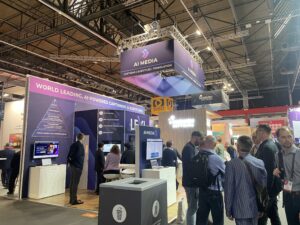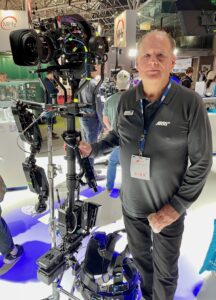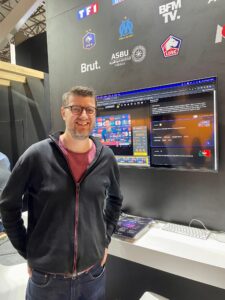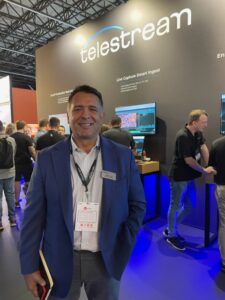Live from IBC 2023: Monday’s latest from Amsterdam
The SVG Europe and SVG Americas teams are onsite in Amsterdam for IBC 2023. As the production and broadcast industry gathers to launch new products and to network, the SVG team is out in force in the exhibition halls of the RAI to gather and share the latest news with the SVG community. You’ll find all the key announcements and news here with daily updates through Monday.
Today’s issue features AI-Media, Arista Networks, Arkona, Arri, Clear-Com, Deltatre, Domo, Edgio, Fujifilm, Grabyo, Haivision, Harmonic, Hitomi Broadcast, Leader, Media Links, Newsbridge, Nextologies, Open Broadcast Systems, Planetcast, Rohde & Schwarz, RTS Intercom Systems, Signiant, Skyline Communications, Telestream, Telos Alliance, TSL, and XD Motion
 AI-Media (Stand 5.C31) is emphasizing the capabilities of its AI-powered live-automatic-captioning solution: LEXI. With the help of artificial intelligence, the solution is making a noticeable impact in real-time captioning cost-effectively. Further updates include the LEXI Captioning Tool Kit to add such features as translation, archiving and search, and disaster recovery. Another technological tentpole is AI-Media’s ALTA solution for IP-compatible closed captioning and subtitling encoding. ALTA supports global broadcast standards like SMPTE ST 2110 and MPEG-TS inputs and can output ST 2110-40, DVB subtitles, DVB TTML, DVB Teletext, and SMPTE ST 2038. Along with effortlessly handling six languages per instance, ALTA also supports insertion of advertising cues using SCTE-35.
AI-Media (Stand 5.C31) is emphasizing the capabilities of its AI-powered live-automatic-captioning solution: LEXI. With the help of artificial intelligence, the solution is making a noticeable impact in real-time captioning cost-effectively. Further updates include the LEXI Captioning Tool Kit to add such features as translation, archiving and search, and disaster recovery. Another technological tentpole is AI-Media’s ALTA solution for IP-compatible closed captioning and subtitling encoding. ALTA supports global broadcast standards like SMPTE ST 2110 and MPEG-TS inputs and can output ST 2110-40, DVB subtitles, DVB TTML, DVB Teletext, and SMPTE ST 2038. Along with effortlessly handling six languages per instance, ALTA also supports insertion of advertising cues using SCTE-35.
Arista Networks (Stand 11.C14) is featuring the further expansion of its suite of media-oriented tools that work to simplify network operations in live-production workflows. The tools comprise EOS, a single high-quality performant operating system that can run on any switch, lowering operational costs and complexities; CloudVision, a single management platform providing advanced configuration, change management, and real-time visibility; Media Control Service, a fast live-production SDN orchestration layer; and an extensive partner ecosystem, using powerful APIs to enable the most efficient broadcast workflows. “The Arista Media offering is world-class,” said Arista systems engineer Gerard Phillips, “and our focus on simplicity, reliability, and visibility enables our customers to focus on their media workflows, knowing that their network will deliver what they need when they need it most.”
Having been announced at NAB 2023, Manifold live-production software is being demonstrated on the Arkona stand (9.C01). Arkona head of sales and business development Erling Hedkvist said, “The thing that impresses people the most is the performance and capacity of Manifold. In one server, we process 1.6TB of media. We’re working on COTS FPGA so the performance is significantly higher than when using CPU. This means the amount of processing you can do takes up very little space and very little power.”

Arri’s Thomas Stoschek
Arri (Stand 12.F21) has responded to the growing trend in live sports production for cinematic images with the Trinity Live, a wireless variation of the firm’s internally recording camera-stabiliser system. “In sports, productions like to have more-emotional images of the players and fans,” noted Arri camera systems sales manager Thomas Stoschek. “That’s why we are increasingly seeing at soccer games, for example, one or two cameras capturing shots with a shallow depth of field. That’s something which our cameras are made for. In addition to the cameras, we are now offering additional equipment like the Trinity Live stabilizer, which helps operators get closer to the players.” The body-mounted stabilisation system includes an arm “like a small crane” to enable both low and high shots, plus a transmitter mounted at the bottom of the arm to act as a counterbalance. It will be available from November.
Clear-Com (Stand 10.D29) is bringing a new level of configuration flexibility to the Eclipse HX. According to Clear Com, VP, product management, Simon Browne, the new Role login feature allows a user to sit at any intercom panel and, via a menu in the panel, select their team (video, maintenance, etc.) and their name to automatically activate their intercom keys. “It dynamically can know which performance space or control room or what position I am in,” he explains, “and I can also use Role login to log into a beltpack. The keys follow me as I walk around. You don’t need to continually reprogram people’s keys, and you can even have your keys on a USB drive, plug it in, and have the panel come up with your configuration.” Clear-Com is also introducing Bluetooth connectivity for its wireless beltpack, allowing talent or someone else to share beltpack communications while someone else uses the wired headset.
Deltatre (Stand 5.H20) has announced the launch of D3 VOLT, an integrated streaming platform for both established streaming operators and new entrants to the market. It offers fully native reference apps across web, mobile, tablet, TV, set-top–box, and game-console applications, as well as new levels of functionality spanning acquisition, packaging, encoding, security, distribution, content management, and playback. D3 VOLT comprises several Deltatre products: AXIS, the UX product to configure streaming services; DIVA, the video player for rich user interactivity; and the FORGE content-management system. The company said, “It is the first platform to be so flexible it can launch new streaming services and grow with them while scaling up the user base and adding substantial new functionality without major revamps.”
Domo (Stand 11.C12) is talking about its Quartz Mesh family of products. The system enables users to enjoy bidirectional IP connectivity to cameras on location, opening up new possibilities for sports broadcasters. “You need only one RF channel per location, so you can have as many cameras using Quartz as you like,” said Domo head of special projects Stuart Brown. “You can browse into the camera and check settings if engineering has told you there’s a fault on your camera. You can add talkback. You can control the camera remotely and even return video.”
Edgio (Stand 5.F18) is touting an enhanced version of its Uplynk solution. Uplynk allows media companies to deliver high-quality streaming experiences to global audiences, while reducing time-to-market and driving operational scale. The company also has announced a partnership with Accedo, Bitmovin, Grabyo, and Vimond to jointly offer a streaming ecosystem that “delivers high-quality linear live or on-demand video while reducing costs and increasing efficiencies.” Edgio is leading the alliance as a Managed Service Provider, working with the other companies to integrate technologies across the streaming tech stack — from content production, personalization, and distribution to user experience and monetisation. Edgio will provide a single point of contact for all support needs, regardless of vendor, as well as Uplynk and CDN. Accedo will do app development, Bitmovin will provide the Video Player and Analytics, and Grabyo will handle clipping and live production. The Content Management System is Vimond.
Fujifilm (Stand 12.B20) is showcasing the new Duvo 24-300 lens, with which it aims to take over the sports-broadcasting market. Around NAB 2023, the company launched the big brother of the 24-300, the 24-1000, which targeted the sports-broadcasting market but has instead had an impact in live events, such as music, given its focal length and depth of field. “We’ve had some success with the 24-1000 in sport, especially in the U.S., but it has ended up in live events and music, noted Fujifilm European product manager Luke Cartwright. “The 24-300 lens, which will start shipping in March 2024, has a good focal length, weighs under 3kg, and is just 270mm long so fits into the short-distance camera, Steadicam, and shoulder work areas really well. The goal at Fujifilm has always been to innovate on what we have and to predict future trends and technologies. Sports broadcasting as a percentage is huge, even if you compare it to theatre and live music: there’s a sports event every day of the week all over the world. That’s why we’re directly attacking this space.”
Grabyo (Stand 5.A20) is showcasing updates for its cloud-native live-production platform. Grabyo Producer now includes keyboard-triggered multi-action sequences and the ability to customise the workspace alongside enhanced vision mixing and replay capabilities. Personalised and localised ads can be inserted into live outputs using SCTE-35 markers and YouTube RTMP markers and can be integrated with playout systems and third-party ad servers. The system also now offers clean/dirty live outputs, multi-track audio outputs, audio compression, and X-Keys device support. The company is also working with Magnifi, bringing enhanced “human-centric” AI to its clipping offering.
Haivision (Stand 2.B32) is all about 5G at IBC. In addition to demonstrating its own 5G-enabled Pro460 mobile video transmitters for live video contribution over cellular networks, the company is participating in 5G connectivity collaborations and demonstrations with Neutral Wireless at the IBC Accelerator stand and B-com (Hall 2, Stand B.39). In addition, Haivision has been shortlisted for an IBC Innovation Award as a part of a team project in this year’s content-creation category for “BBC: Building a pop-up 5G network for the coronation of King Charles II.” Haivision VP, marketing, Marcus Schioler sees the use of private 5G networks for live sports production as a reality today and expects the use of such networks to escalate significantly in the next 12-24 months.
Harmonic (Stand 1.B20) has launched a targeted advertising ecosystem through strategic partnerships with Google Ad Manager and Equativ. Harmonic is now an Integrated Streaming Ecosystem partner with Google Ad Manager, which enables Harmonic’s VOS360 Ad SaaS to foster a more open ecosystem for server-side ad insertion (SSAI) and allows publishers to seamlessly optimize ad delivery, fill rates, and demand to significantly increase revenue. Integration between Harmonic’s SSAI solution and Google Ad Manager enables scalable access to Google Ad Manager’s monetization suite, including flexible demand types, formats, AI-driven insights, and ad-quality controls, resulting in a higher-quality advertising and viewing experience.
Hitomi Broadcast (Stand 10.A42) is demonstrating the seamless operation of its workflow solutions to one of the most persistent and increasing issues in live and remote productions: ensuring perfect synchronisation between audio and video. At the heart of Hitomi’s solution suite is MatchBox for accurate lip-sync measurements. Assisting in end-to-end assessment, MatchBox Glass, a free-to-download iPhone app, streamlines the process of setting up each feed based on objective data and eliminating guesswork. Said Hitomi Broadcast director Russell Johnson, “The annoyance that lip-sync errors bring, whether it’s an audio-visual mismatch of speech or delayed sports commentary, is universal. With MatchBox, we provide an exact calculation of latencies and delays so that production companies can prove that their feed is perfectly synchronised. Events like IBC allow us to demonstrate to attendees, within a matter of moments, the ease of its application.”

Leader’s Kevin Salvidge
New for IBC on the Leader stand (10.C01) is the LT4670, a 1U full-rack-size sync generator designed to ease the migration from SDI to IP. “Customers adopting IP now have a clearer idea of the reference-generator test-pattern requirements, said “Leader European sales engineering and technical marketing manager Kevin Salvidge. “In simplest terms, they want the tools they had with SDI but in IP, and the LT4670 will give them that capability. It includes enhanced features like dual GNSS and GPS connections, providing diversity, and dual hot-swappable power supplies and fans as broadcast products more closely resemble those that would be installed in data centres.” Also on show and making their European debut are the LV5600 waveform monitor and LV7600 rasterizer with JPEG XS option via software upgrade. Added Salvidge, “We’re now seeing more and more live productions using JPEG XS because of its low-latency, lossless performance.”
Media Links (Stand 1.A59.) is showcasing it new Xscend IP Media Platform for the first time in Europe. Introduced at NAB 2023, Xscend is a dense, versatile IP media platform designed for the network edge. It incorporates an adaptable, media-tuned architecture that can accommodate evolving network protocols, physical interfaces, codec algorithms, and video formats for a wide variety of applications. According to Media Links senior product manager, software solutions, Mark Podesla, it provides broadcasters and service providers with the technological solution to transport up to 128 contribution-quality services across both fully managed and unmanaged IP networks, including 4K video and 25-Gbps hitless video and data. Xscend addresses the migration from SDI-to-IP as well as IP-to-IP environments.

Newsbridge’s Frédéric Petitpont
Newsbridge (Stand 7.C30) is highlighting new features for its MXT-1 AI video-indexing technology, which launched in beta mode in April and is now being rolled out to broadcasters, TV channels, and sports rights holders. Capable of indexing more than 500 hours of video per minute, including metadata and descriptions, MXT-1 scooped up an IABM award here and is described as a “game-changer” for anyone working with live and archived media, sports, and entertainment content. Newsbridge co-founder and CEO Frédéric Petitpont provided a demonstration of some of the new features, including automatic media summaries and the ability to automatically create titles, descriptions, tags, and chapters to speed publishing to social and digital channels. MXT-1 also allows users to view descriptions and summaries in English, French, Spanish, Italian, German, Portuguese, and Arabic, with more languages to be added.
Nextologies (Stand 1.D07) is launching its NXT-MCR remote–master-control solution. The hybrid product is designed to provide a unified remote master-control interface for live event production and to orchestrate incoming satellite and/or IP signals, video routers, video switchers, audio comms, video monitoring, scheduling systems, and prerecorded files. Among its benefits are increased flexibility, greater visibility, lower operator costs, and no capex investment.
Open Broadcast Systems (Stand 1.A40C) is offering a demo of the OneWeb Low Earth Orbit (LEO) video-contribution system. Working with Network Innovations, OneWeb, and Zixi, the company is delivering a live broadcast-quality video feed from the Network Innovations facility in Essel, Netherlands, to the IBC 2023 exhibit floor. The demo follows the company’s world-first use of OneWeb to deliver a UEFA Champions League match from the Faroe Islands in July. Although it’s still one to three years from becoming a standard option, working this way could be an effective option for Tier 2 sports that require more than bonded cellular but won’t (or can’t) go as far as a satellite truck, said Open Broadcast Systems managing director Kieran Kunhya. The company is particularly keen to talk to broadcast-services providers working closely with sports broadcasters.
Planetcast (Stand 5.H78) is promoting a unified service layer that enables users to access its suite of content-preparation, enhancement, distribution, and monetisation products and services. Over the past year, Planetcast has been building out its product portfolio organically by developing its distribution suite (Playout and IP distribution) and through acquiring products like Contido (content management) and BATS (billing and subscription) as well as forming strategic partnerships with such companies as Switch media (OTT platform) and Wurl (ad tech). Demos of the Planetcast product suite will include solutions for content management, preparation and enhancement, playout, FAST and OTT. The Planetcast team are also showcasing Recaster, an IP transport solution that delivers a secure internet stream from anywhere to anywhere, be it a linear channel or a live sports stream.
Anyone on the hunt for storage without the fear of downtime will want to check out Rohde & Schwarz’s (Stand 7.B21) SpyCerNode Two. it has a layer of IP technology called VSA (Virtual Storage Access) and eliminates downtime for users connected through a VSA appliance or client, says Rohde & Schwarz VP, broadcast and media, Erik Balladares. “We are also showing a new control panel for our Pixel Power product line which helps with automation,” he adds. “And, on the studio content-ingest side, Venice is an eight-channel server that will be transitioning over to software in the future. That will support all the various workflows for studio ingest, including VTR emulation and ingest for archives, where people are still getting things off tape.”
RTS Intercom Systems (Stand 11.D09) has added NMOS support to its products via RNP, which acts as a proxy between RTS OMNEO-based devices and non-RTS NMOS third-party products. “We also have the different IS standards like IS-4 (for discovery and registration), IS-5 (for device connection management), and IS-08, which is audio-channel mapping,” says RTS sales director Martin Liermann. “We also have a PH Plus headset that will be available next year and is super lightweight and comfortable, inspired by one of our most successful aviation headsets. There is a dual-side version and a single-sided version, and we are already seeing that people will want to use it in other applications.”
Visitors to the Signiant stand (5.B82) can see several innovations that can improve the way live sports content is streamed to fans. The Jet feature for automating and monitoring file transfers now supports cloud-to-cloud operations for mission-critical transport where both source and destination are public-cloud endpoints. Jet now supports both on-premises and cloud storage endpoints. One of last year’s launches, Media Engine, has also been enhanced, allowing SaaS customers to search, preview, and take action on media assets across all Signiant-connected storage from anywhere in the world. New features for Media Engine at IBC 2023 include the ability to generate and retrieve clips, Adobe Premiere Pro panel integration, and Proxyless Play.
Skyline Communications (Stand 1.A63) is emphasizing its DataMiner Integration Studio (DIS), a comprehensive extension of Microsoft Visual Studio. Offered to all users at no cost, it is designed for DataMiner DevOps Professionals to facilitate the creation and continuous evolution of a broad variety of plug-in components across the DataMiner platform. In addition, the company has partnered with Appear to integrate its technology into DataMiner for increased management and monitoring of primary and linear/OTT distribution projects. Demos of the partnership can be seen at Appear’s booth (Stand 1.C61).

Telestream’s Charlie Dunn
Enabling remote production, aiding with HDR/SDR workflows, and helping organisations use the cloud to scale up for events are among the trends that Telestream (Stand 7.B11) is responding to. Said Telestream chief product officer Charlie Dunn, “We think JPEG XS will continue to have growth and help in those areas. Because of the nature of sport, doing things in the cloud makes sense: [for example,] spinning up infrastructure for a three- or four-week tournament lends itself to cloud. Also, for sport, a lot of activity is focused on turning around highlights swiftly,” he added, “and that’s efficiently done with our tools. Remote production will make covering more of the smaller events possible, and, again, the cloud provides the perfect opportunity for that. A lot of people are replacing satellite and dark fibre with SRT; our tools allow for monitoring when that content leaves and arrives at venues, and we can also do cloud native monitoring, thanks to our IneoQuest portfolio.”
Telos Alliance (Stand 8.C45) is demonstrating the Infinity VIP App. First shown at NAB 2023, the app is part of the firm’s strategy to offer virtual audio solutions as part of its growing virtual ecosystem. Available for download from the Google Play and Apple App Store, the app mirrors the HTML5 browser-based VIP panel offering with functionality to support peer-to-peer comms, groups, partylines – all the elements users might expect in a matrix intercom but in a virtualised form with no central matrix core.
TSL (Stand 10.B41) is showcasing its MPA1-MIX-NET-V-R for the first time here. The fully redundant 1U audio confidence monitor and mixer with 16 instantly recallable independent mixes is engineered in accordance with key industry standard SMPTE ST 2022-7, ensuring fully optimised network topologies that reduce customer risk and network complexity without limiting operational agility. It is designed to safeguard against disruptions and system failures, empowering broadcasters to deliver top-tier, uninterrupted broadcasting experiences. “It is increasingly clear that IP is the future,” said TSL president Ian Godfrey. “To get there, we have to build products that provide a bridge to the new IP paradigm with familiar workflows and monitoring tools but will also be completely at home in an all-IP world.”
XD Motion (Stand 12.B45A) is highlighting innovations in VR, AR, automation, and robotic cameras, including the latest Arcam 20 robotic camera system and IO.Bot software. The six-axis robotic arm of the Arcam provides full motion control and is designed to operate safely around people. It is programmed to move in 3D within a virtual sphere with a diameter of 2.5m (Arcam 10) or 3.5m (the new Arcam 20). An optional dolly can support the arm upside down. Said new XD Motion CCO Andrew Gordon, “Arcam 20 allows us to start addressing sports broadcasters’ needs more. We’ve still got Arcam 10, which has a 1.3m reach and a substantial payload of 12.5kg, but, given ever increasing technology requirements and therefore additional weight requirements with the more specialised equipment that sports broadcasters use, with Arcam 20, we are now at a 20kg payload and 1.75m reach. This means sports broadcasters can use it for a significant number of different needs: [for example,] from a studio perspective, with two robots, teleportation is more possible as the payload increase, and better range of motion means that synchronisation of the subjects which are going to interact with each other is improved.”

